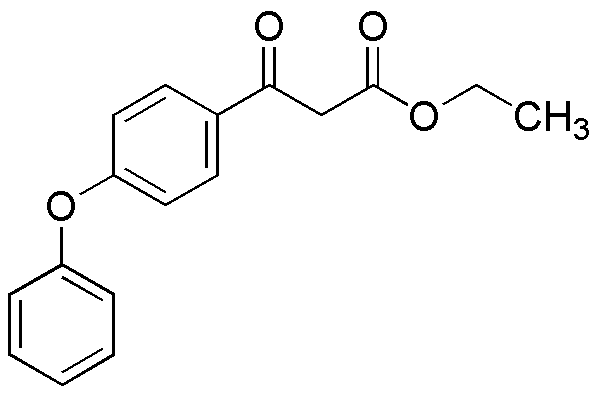Ethyl 3-oxo-3-(4-phenoxyphenyl)propanoate is widely utilized in research focused on:
- Pharmaceutical Development: This compound serves as an intermediate in the synthesis of various pharmaceuticals, particularly in the development of anti-inflammatory and analgesic drugs, providing a pathway for creating effective medications.
- Agricultural Chemicals: It is used in the formulation of agrochemicals, such as herbicides and fungicides, enhancing crop protection and yield by targeting specific pests and diseases.
- Material Science: The compound plays a role in the production of specialty polymers and resins, which are essential in creating durable materials for coatings and adhesives, offering superior performance compared to traditional options.
- Research in Organic Synthesis: It is a valuable reagent in organic chemistry, allowing researchers to explore new synthetic pathways and develop innovative compounds with unique properties.
- Cosmetic Formulations: Ethyl 3-oxo-3-(4-phenoxyphenyl)propanoate is incorporated into cosmetic products for its potential skin-beneficial properties, contributing to formulations aimed at improving skin health and appearance.
General Information
Properties
Safety and Regulations
Applications
Ethyl 3-oxo-3-(4-phenoxyphenyl)propanoate is widely utilized in research focused on:
- Pharmaceutical Development: This compound serves as an intermediate in the synthesis of various pharmaceuticals, particularly in the development of anti-inflammatory and analgesic drugs, providing a pathway for creating effective medications.
- Agricultural Chemicals: It is used in the formulation of agrochemicals, such as herbicides and fungicides, enhancing crop protection and yield by targeting specific pests and diseases.
- Material Science: The compound plays a role in the production of specialty polymers and resins, which are essential in creating durable materials for coatings and adhesives, offering superior performance compared to traditional options.
- Research in Organic Synthesis: It is a valuable reagent in organic chemistry, allowing researchers to explore new synthetic pathways and develop innovative compounds with unique properties.
- Cosmetic Formulations: Ethyl 3-oxo-3-(4-phenoxyphenyl)propanoate is incorporated into cosmetic products for its potential skin-beneficial properties, contributing to formulations aimed at improving skin health and appearance.
Documents
Safety Data Sheets (SDS)
The SDS provides comprehensive safety information on handling, storage, and disposal of the product.
Product Specification (PS)
The PS provides a comprehensive breakdown of the product’s properties, including chemical composition, physical state, purity, and storage requirements. It also details acceptable quality ranges and the product's intended applications.
Certificates of Analysis (COA)
Search for Certificates of Analysis (COA) by entering the products Lot Number. Lot and Batch Numbers can be found on a product’s label following the words ‘Lot’ or ‘Batch’.
*Catalog Number
*Lot Number
Certificates Of Origin (COO)
This COO confirms the country where the product was manufactured, and also details the materials and components used in it and whether it is derived from natural, synthetic, or other specific sources. This certificate may be required for customs, trade, and regulatory compliance.
*Catalog Number
*Lot Number
Safety Data Sheets (SDS)
The SDS provides comprehensive safety information on handling, storage, and disposal of the product.
DownloadProduct Specification (PS)
The PS provides a comprehensive breakdown of the product’s properties, including chemical composition, physical state, purity, and storage requirements. It also details acceptable quality ranges and the product's intended applications.
DownloadCertificates of Analysis (COA)
Search for Certificates of Analysis (COA) by entering the products Lot Number. Lot and Batch Numbers can be found on a product’s label following the words ‘Lot’ or ‘Batch’.
*Catalog Number
*Lot Number
Certificates Of Origin (COO)
This COO confirms the country where the product was manufactured, and also details the materials and components used in it and whether it is derived from natural, synthetic, or other specific sources. This certificate may be required for customs, trade, and regulatory compliance.


